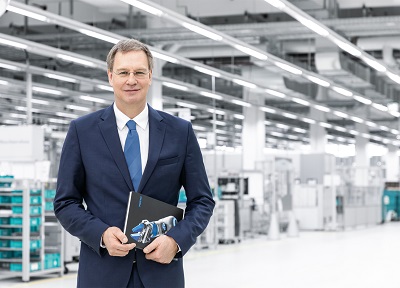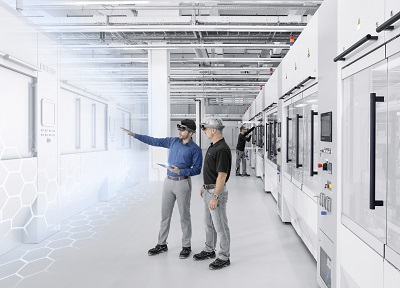The growing pace of technological change, political disputes over trade relations and increasingly dismal prospects for the global economy are putting the manufacturing industry under pressure, according to officials at Festo, Esslingen am Neckar, Germany. The Corona pandemic is a particular challenge, and it clearly shows the importance of digital transformation and Industrie 4.0, they said.

Oliver Jung is Chairman of Festo’s Management Board.
Thousands of companies, like Festo, have sent their employees to work at home. In this way, many areas of the economy have been able to stay afloat because digitalization has advanced extensively in the private sphere. But many production jobs are location-bound. The basic principles of Industrie 4.0 will make mobile working possible in industrial production of the future, and the crisis has driven digitalization worldwide.
“We are feeling Corona very clearly through changes in our online business. This trend will be a lasting, long-term one: a sustained shift to digital channels and offerings. We realize more than ever that in times of crisis it is crucial to provide our customers with comprehensive virtual support,” said Oliver Jung, Chairman of the Management Board. Therefore, Festo provided customers and partners with a digital collaboration platform that contains engineering tools, an online shop, access to all Festo services and the digital maintenance manager Smartenance. This enabled Festo to offer its customers and partners consistent touchpoints in the virtual world.
Many companies were suddenly confronted with a completely different demand behavior. Faster availability or suddenly much higher quantities of certain products required companies to be as flexible as possible when converting their production. The digitalization of automation technology provides a remedy. Components that are intelligently networked independently, self-configuring and thus plug-and-produce capable, enable the systems to meet changing requirements faster. The necessary data and information are synchronized via cloud services and can be accessed at any time.
In Festo’s global production network, plants are networked with each other and are in constant exchange. “Within the network, we have largely been able to compensate for production bottlenecks, for example when plant shutdowns ordered by the authorities occur. This requires a stable and powerful IT infrastructure that can cope with modern possibilities such as cloud data storage, so that all data is available worldwide in near real-time,” said Ansgar Kriwet, Member of the Management Board Sales.

The digitalization of automation technology will foster advances in global production, according to Festo officials.
The trend towards intelligently networked production is proving to be crisis-proof and sustainable, they said. A prerequisite for this is the virtualization of products, machines and systems, so that factory workers will also be able to control “their” machine from their home office. To do this, machines and systems require a digital twin that is equipped with the same functions as its real counterpart. Embedded sensor technology enriches the digital twin with process data and users gain insight into the internal condition of the machines.
These virtual twins of machinery, systems and value flows have another great advantage: The processes, parameterizations and configurations can be acted out in these computer-generated simulations without the need to intervene in existing production processes. This saves costs and time — which is crucial for countries with a high labor content in manufacturing costs, so that they can remain competitive on the global market.
Platform Industrie 4.0
The central driver of the digital transformation is the Platform Industrie 4.0, which supports German companies as well as numerous international cooperations. “Our mission statement 2030 with its three focal points sovereignty, interoperability and sustainability provides an excellent framework for action to emerge from the crisis stronger and to expand our global pioneering role in open, digital ecosystems,” said Frank Melzer, Member of the Management Board for Product and Technology Management.
AI is key
With AI there is further added value for Festo customers and also for Festo itself. “Artificial intelligence can be used to make predictions about possible failures of individual components or optimization potential available to the machine operator. In combination with human experience, we have already been able to achieve significant efficiency improvements in our own plants,” said Kriwet. Artificial intelligence is characterized by its self-learning ability. The more data available, the better the predictions. As a result, downtime and expensive rejects are reduced.
To generate added value and increase efficiency with the methods from the algorithmic toolbox, use cases must be precisely defined. Satisfactory results are only possible if the data are strategically prestructured and are available in sufficient quantity. “We have taken a close look at quality assurance with AI in a production process at our own factories and have come to the conclusion that the big data approach from the consumer market is not successful in industry. We only managed to significantly increase efficiency once we united the expertise of the machine operators with the appropriate statistical methods of AI,” said Jung.
Festo is currently focusing above all on AI assessments “on edge,” in other words directly on the component or on location within a production network. This saves costs, ensures real-time assessments and avoids latencies. With the Festo IoT Gateway, existing production plants can be made AI-capable without major intervention. Algorithms and models can be updated directly on a device without modifying the PLC, independently of the computer capacity or the free resources of the PLC.
Smart products
“In order to be able to exploit the opportunities and advantages of Industrie 4.0, we need mechanically excellent and additionally smart products at the field level that have integrated computing power and communication capabilities. We have therefore combined the outstanding mechanical properties of piezo valves with a digitally controlled variety of functions in a unique product, the Festo Motion Terminal,” said Kriwet.
Functions of the valve terminal can be controlled via app so that different tasks can be performed with the same hardware. “The Festo Motion Terminal combines standard pneumatics, electronics and software control to create intelligent technology. This ranges from simple directional control valves to complex motion tasks, status monitoring, variable positioning, reduced energy consumption and significantly fewer components that need to be installed. With the Festo Motion Terminal, we open up completely new solution areas for our customers,” said Kriwet.
Festo
www.festo.com/us
Filed Under: Pneumatic Tips